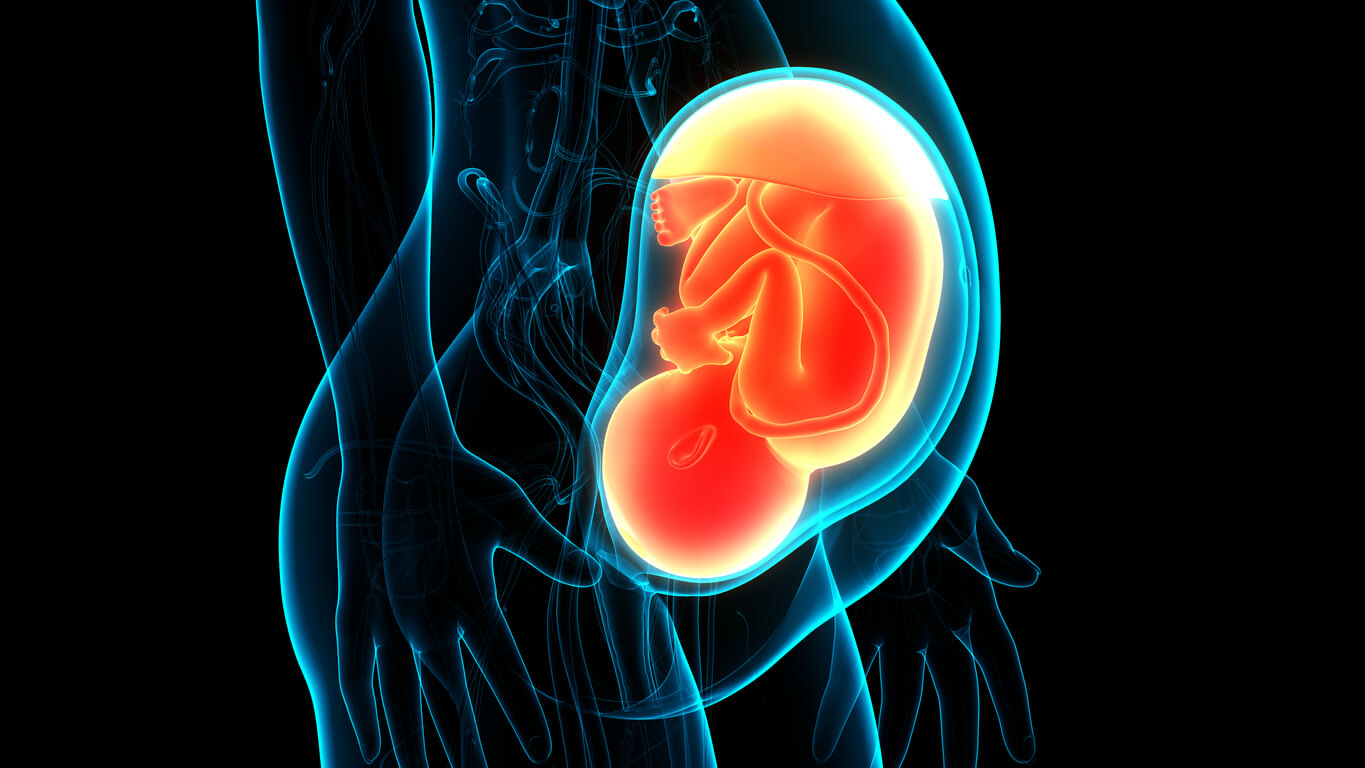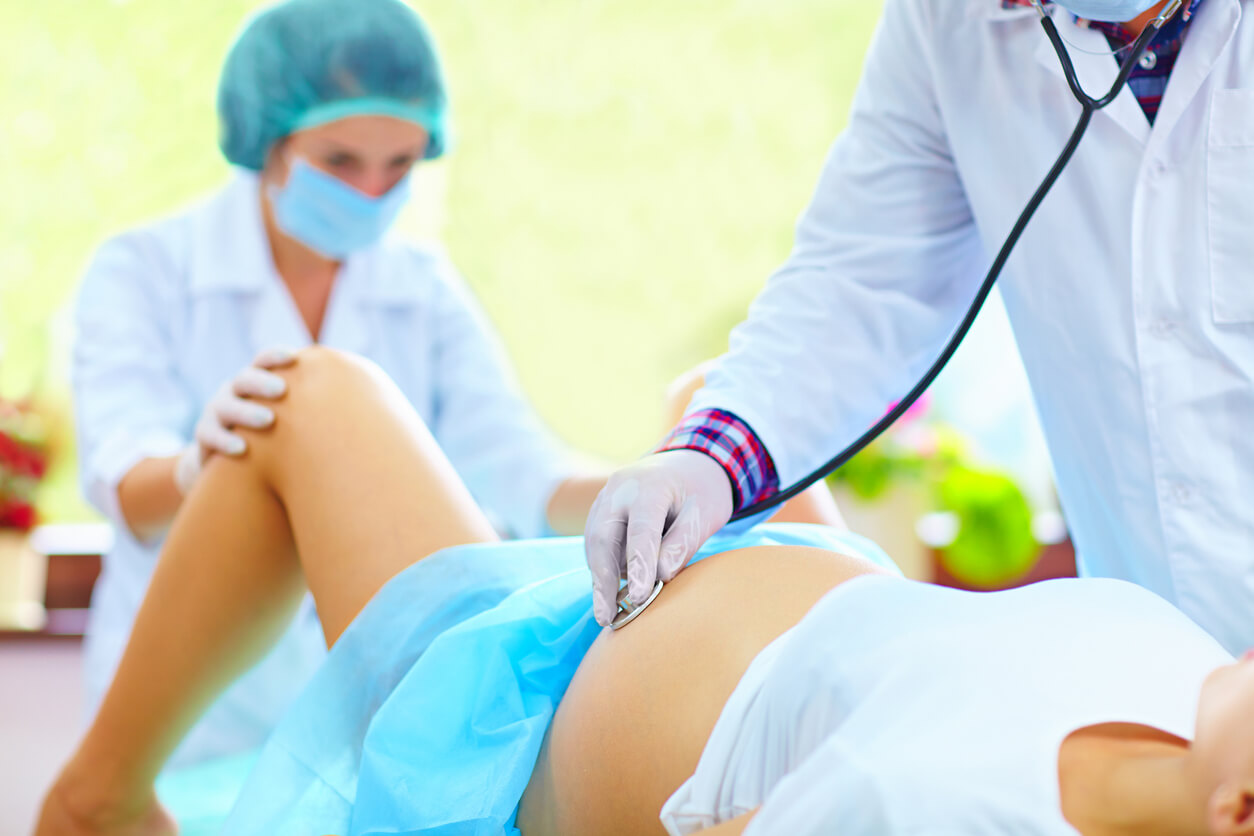A Mother's Organs During Pregnancy


Written and verified by the nurse Leidy Mora Molina
It’s a fact that during pregnancy, all of the mother’s organs undergo changes in order to keep the baby healthy, comfortable, and protected inside her. The endocrine, gastrointestinal, circulatory, cardiorespiratory, renal, and skeletal muscle systems respond to this transitory condition.
But for these changes to take place, pregnancy hormones must take center stage and favor the adaptation of each tissue. This process begins at the beginning of pregnancy and the physical changes become visible around the 20th week. But what are the changes that occur in the mother’s organs during pregnancy? We’ll tell you in the following article.
Learn how a mother’s organs change during pregnancy
From the moment of fertilization, the maternal body begins a perfect transformation that seeks to give space and life to the new being in formation. These changes are guided by the endocrine system, which increases the secretion of pregnancy hormones, such as human chorionic gonadotropin (hCG), progesterone, estrogens, and relaxin, among others.
In this way, these chemical messengers travel through the blood to each of the maternal organs and prepare them to modify their structure and function. The first structures to respond to these stimuli are the breasts and the uterus, as they must increase their network of blood vessels and undergo some significant changes in their anatomy to perform their gestational functions.
The anatomical transformation of the mother’s body becomes visible between the 13th and 20th week, after the baby, already formed, begins to grow at great speed. This generates a displacement of the abdominal organs and an increase in the distensibility of the tissues, in order to make room for the gravid uterus within the abdominal cavity.
Changes in the uterus
The uterus changes from the beginning of pregnancy and at that time, it must increase its blood vascularization and the thickness of its tissues in order to accommodate a new life. As a result, it goes from weighing about 1.7 ounces to about 35 ounces and from measuring about 2.4 inches high to approximately 13 inches. In addition, its walls also become more flexible and stretch about 20 times more than normal due to the action of the hormone relaxin.

Changes in the gastrointestinal system
When the uterus begins to grow, the abdominal organs are compressed and begin to move upward in order to make room for the baby. In particular, the small and large intestines relocate, and this increases the pressure on the maternal stomach, decreases its storage capacity, and increases gastroesophageal reflux.
On the one hand, the feeling of fullness in the mother after eating will come earlier than usual and her digestion will slow down. On the other hand, intestinal displacement and the action of progesterone affect the digestive system. This favors a decrease in the tone of its walls and a slowing of transit, which brings with it one of the most common discomforts of pregnancy: Constipation.
The appendix also rises in the abdominal cavity, while the liver responds by temporarily shrinking in size. Even so, it continues to function normally.
Adaptation of the respiratory system
Certainly, the respiratory system also modifies its functioning during pregnancy. From the first weeks, there’s a dilation of the capillaries of the nasal, oropharyngeal, and laryngeal mucosa. This leads to increased absorption of medications and risk of nosebleeds.
In addition, some mothers may suffer from gestational rhinitis.
The capacity inside the rib cage decreases up to 1.6 inches due to the pressure exerted by the abdominal organs on the diaphragm. This causes the lungs to reduce their volume by 25 % and creates a sensation of shortness of breath in the mother, especially in the last trimester.
Cardiovascular changes
From the first weeks of pregnancy, the cardiovascular system adapts to the oxygen and nutrient demands of both the mother and the baby. For this, there’s an increase in vascularization in all maternal tissues, to a greater degree in the breasts and uterus.
Consequently, the mother’s blood volume increases by 35%, which is approximately one and a half liters more than usual. Similarly, cardiac output increases, i.e., the amount of blood pumped by the heart per minute.

Changes in the renal system
The renal system also responds to pregnancy hormones. The kidneys move upward as the uterus grows. In addition, the renal pelvis, calyces, and ureters dilate, causing them to increase in size. The action of progesterone on the urinary bladder causes it to fill more quickly and consequently, the urge to urinate becomes more frequent from the beginning of pregnancy. Especially in the last trimester, when the uterus increases in size and compresses it.
Unfortunately, all the anatomical changes in the renal system make pregnant women more prone to urinary tract infections. For this reason, it’s important to have regular prenatal check-ups and urine tests.
Adaptations in the musculoskeletal system
During gestation, the mother gains an average of 26.5 pounds. To compensate for this weight gain, the body’s center of gravity shifts upward and forward. This generates postural and osteoarticular modifications, such as changes in the anterior-posterior curvatures of the spine, especially in the lumbar area.
In addition, due to the action of relaxin, ligament laxity increases and joint hypermobility is produced. This will help to modify the posture of the pelvis and increase the elasticity of all tissues during labor. For this reason, cartilage, ligaments, and other soft tissues become more flexible at this stage.
Although the body produces all these modifications naturally, it’s normal for the mother to suffer discomfort at this stage. For example, pain in the uterus and back, gastrointestinal discomfort, edema, and skin disorders.
After delivery, a mother’s organs return to their original place
When the baby is born, the mother’s organs that have been displaced slowly return to their original position. The uterus begins its involution with spontaneous and somewhat constant contractions known as intussusception. In addition, all the abdominal organs begin to reorganize and the changes in the cardiovascular, respiratory, and renal systems are reversed. Some of these changes are drastic, while others take longer during the puerperium period.
The transformation that occurs in the mother’s body during gestation is impressive, and everything occurs in favor of creating, developing, and housing the new being in just 40 weeks. During this time, it’s important to be aware of the normal adaptations of the maternal anatomy. That’s why, in case of any doubts, we recommend that you clarify them with your healthcare provider.
It’s a fact that during pregnancy, all of the mother’s organs undergo changes in order to keep the baby healthy, comfortable, and protected inside her. The endocrine, gastrointestinal, circulatory, cardiorespiratory, renal, and skeletal muscle systems respond to this transitory condition.
But for these changes to take place, pregnancy hormones must take center stage and favor the adaptation of each tissue. This process begins at the beginning of pregnancy and the physical changes become visible around the 20th week. But what are the changes that occur in the mother’s organs during pregnancy? We’ll tell you in the following article.
Learn how a mother’s organs change during pregnancy
From the moment of fertilization, the maternal body begins a perfect transformation that seeks to give space and life to the new being in formation. These changes are guided by the endocrine system, which increases the secretion of pregnancy hormones, such as human chorionic gonadotropin (hCG), progesterone, estrogens, and relaxin, among others.
In this way, these chemical messengers travel through the blood to each of the maternal organs and prepare them to modify their structure and function. The first structures to respond to these stimuli are the breasts and the uterus, as they must increase their network of blood vessels and undergo some significant changes in their anatomy to perform their gestational functions.
The anatomical transformation of the mother’s body becomes visible between the 13th and 20th week, after the baby, already formed, begins to grow at great speed. This generates a displacement of the abdominal organs and an increase in the distensibility of the tissues, in order to make room for the gravid uterus within the abdominal cavity.
Changes in the uterus
The uterus changes from the beginning of pregnancy and at that time, it must increase its blood vascularization and the thickness of its tissues in order to accommodate a new life. As a result, it goes from weighing about 1.7 ounces to about 35 ounces and from measuring about 2.4 inches high to approximately 13 inches. In addition, its walls also become more flexible and stretch about 20 times more than normal due to the action of the hormone relaxin.

Changes in the gastrointestinal system
When the uterus begins to grow, the abdominal organs are compressed and begin to move upward in order to make room for the baby. In particular, the small and large intestines relocate, and this increases the pressure on the maternal stomach, decreases its storage capacity, and increases gastroesophageal reflux.
On the one hand, the feeling of fullness in the mother after eating will come earlier than usual and her digestion will slow down. On the other hand, intestinal displacement and the action of progesterone affect the digestive system. This favors a decrease in the tone of its walls and a slowing of transit, which brings with it one of the most common discomforts of pregnancy: Constipation.
The appendix also rises in the abdominal cavity, while the liver responds by temporarily shrinking in size. Even so, it continues to function normally.
Adaptation of the respiratory system
Certainly, the respiratory system also modifies its functioning during pregnancy. From the first weeks, there’s a dilation of the capillaries of the nasal, oropharyngeal, and laryngeal mucosa. This leads to increased absorption of medications and risk of nosebleeds.
In addition, some mothers may suffer from gestational rhinitis.
The capacity inside the rib cage decreases up to 1.6 inches due to the pressure exerted by the abdominal organs on the diaphragm. This causes the lungs to reduce their volume by 25 % and creates a sensation of shortness of breath in the mother, especially in the last trimester.
Cardiovascular changes
From the first weeks of pregnancy, the cardiovascular system adapts to the oxygen and nutrient demands of both the mother and the baby. For this, there’s an increase in vascularization in all maternal tissues, to a greater degree in the breasts and uterus.
Consequently, the mother’s blood volume increases by 35%, which is approximately one and a half liters more than usual. Similarly, cardiac output increases, i.e., the amount of blood pumped by the heart per minute.

Changes in the renal system
The renal system also responds to pregnancy hormones. The kidneys move upward as the uterus grows. In addition, the renal pelvis, calyces, and ureters dilate, causing them to increase in size. The action of progesterone on the urinary bladder causes it to fill more quickly and consequently, the urge to urinate becomes more frequent from the beginning of pregnancy. Especially in the last trimester, when the uterus increases in size and compresses it.
Unfortunately, all the anatomical changes in the renal system make pregnant women more prone to urinary tract infections. For this reason, it’s important to have regular prenatal check-ups and urine tests.
Adaptations in the musculoskeletal system
During gestation, the mother gains an average of 26.5 pounds. To compensate for this weight gain, the body’s center of gravity shifts upward and forward. This generates postural and osteoarticular modifications, such as changes in the anterior-posterior curvatures of the spine, especially in the lumbar area.
In addition, due to the action of relaxin, ligament laxity increases and joint hypermobility is produced. This will help to modify the posture of the pelvis and increase the elasticity of all tissues during labor. For this reason, cartilage, ligaments, and other soft tissues become more flexible at this stage.
Although the body produces all these modifications naturally, it’s normal for the mother to suffer discomfort at this stage. For example, pain in the uterus and back, gastrointestinal discomfort, edema, and skin disorders.
After delivery, a mother’s organs return to their original place
When the baby is born, the mother’s organs that have been displaced slowly return to their original position. The uterus begins its involution with spontaneous and somewhat constant contractions known as intussusception. In addition, all the abdominal organs begin to reorganize and the changes in the cardiovascular, respiratory, and renal systems are reversed. Some of these changes are drastic, while others take longer during the puerperium period.
The transformation that occurs in the mother’s body during gestation is impressive, and everything occurs in favor of creating, developing, and housing the new being in just 40 weeks. During this time, it’s important to be aware of the normal adaptations of the maternal anatomy. That’s why, in case of any doubts, we recommend that you clarify them with your healthcare provider.
All cited sources were thoroughly reviewed by our team to ensure their quality, reliability, currency, and validity. The bibliography of this article was considered reliable and of academic or scientific accuracy.
- Carrillo, P. (2021). Cambios fisiológicos durante el embarazo normal. Vol. 64, n.o1, Enero-Febrero 2021.
- Gómez, A. (2000). Cambios anatómicos y fisiológicos del embarazo: sus implicancias anestesiológicas. Rev. Arg. Anest (2000), 58, 6: 339-344.
- Klein, S; Miller, S; Thomson, F. (2013). Un libro para las parteras. EEUU. Recuperado de : https://es.hesperian.org/hhg/Un_libro_para_parteras
- Pérez, A; Roche M. (2009). Patología médica y embarazo. Trastornos gastrointestinales, neurológicos, cardiovasculares y dermatológicos. España. Revista An. Sist. Sanit. Navar Volumen 32. (Supl.1).
- Purizaca, M. (2010). Modificaciones fisiológicas en el embarazo. Perú. Revista Peruana de Ginecología y Obstetricia, vol. 56, núm.1. Recuperado de: https://www.redalyc.org/pdf/3234/323428195010.pdf
This text is provided for informational purposes only and does not replace consultation with a professional. If in doubt, consult your specialist.








